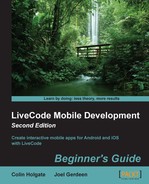Now, let's try running our tests on physical devices. Get your USB cables ready and connect the devices to your computer.
Lets go through the steps for an Android device first:
- You should still have Android selected in Standalone Application Settings.
- Get your device to its home screen past the initial Lock screen if there is one.
- Choose Development/Test Target and select your Android device. It may well say "Android" and a very long number.
- Choose Development/Test.
- The stack should now be running on your Android device.
Now, we'll go through the steps to test a simple stack on an iOS device:
- If you have not read Chapter 7, Deploying to Your Device, on how to deploy the current environment to your device or the Apple pages or have not installed certificates and provisioning files, you will have to skip this test for now.
- Change the Standalone Application Settings back to iOS.
- Under Basic Application Settings of the iOS settings is a Profile drop-down menu of the provisioning files that you have installed. Choose one that is configured for the device you are going to test.
- Close the dialog box and choose Save as Standalone Application… from the File menu.
- In Finder, locate the folder that was just created and open it to reveal the app file itself. As we didn't give the stack a sensible name, it will be named Untitled 1.
- Open
Xcode, which is in theDeveloperfolder you installed earlier, in theApplicationssubfolder. - In the
Xcodefolder, choose Devices from the Window menu if it isn't already selected. - You should see your device listed. Select it and if you see a button labeled Use for Development, click on that button.
- Drag the app file straight from the Finder menu to your device in the Devices window. You should see a green circle with a + sign. You can also click on the + sign below Installed Apps and locate your app file in the Finder window. You can also replace or delete an installed app from this window.
- You can now open the app on your iOS device!
In addition to getting a test stack to work on real devices, we also saw how easy it is, once it's all configured, to test a stack, straight on an Android device. If you are developing an app that is to be deployed on both Android and iOS, you may find that the fastest way to work is to test with the iOS Simulator for iOS tests, but for this, you need to test directly on an Android device instead of using the Android SDK virtual devices.
Until recently, the Android support for the Nook Color from Barnes & Noble wasn't good enough to install LiveCode apps. It seems to have improved though and could well be another worthwhile app store for you to target.
Investigate about the sign up process, download their SDK, and so on. With any luck, some of the processes that you've learned while signing up for the other stores will also apply to the Nook store. You can start the signing up process at
